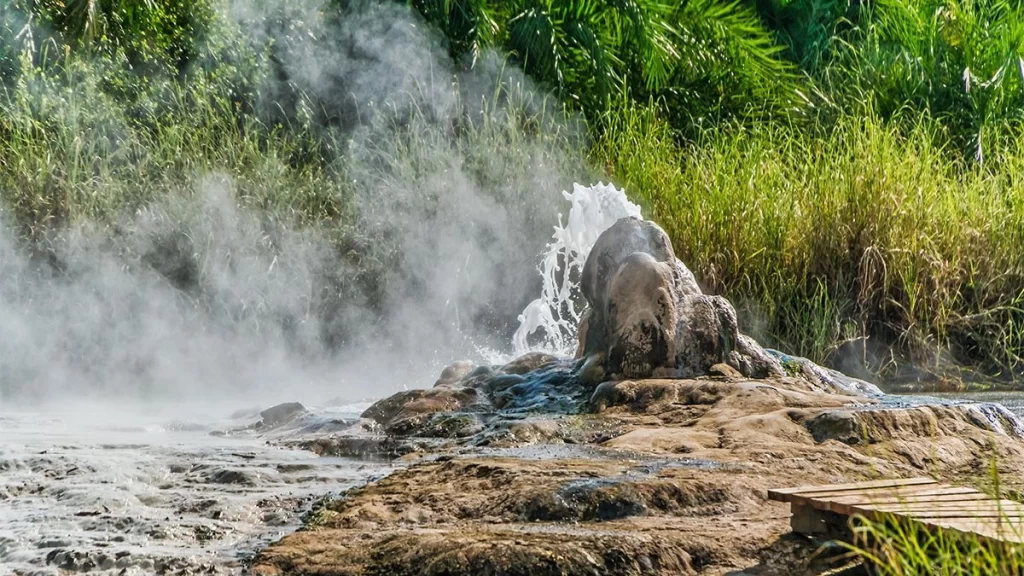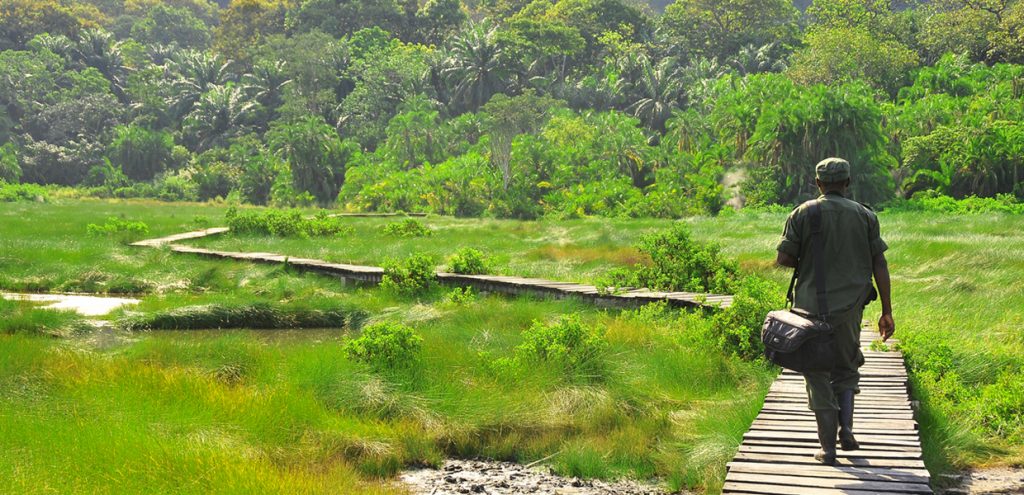Things To Do in Semuliki National Park
Things To Do in Semuliki National Park , Your safari vacation should undoubtedly be a once-in-a-lifetime experience, with attractions and activities in Semuliki National Park. Uganda safari expeditions with the potential for intimate interactions with fauna, Secluded and pristine, Uganda’s virgin landscapes offer exceptional opportunities. Semuliki National Park is situated on the border of Uganda and the Democratic Republic of the Congo. The park is situated inside the Albertine Rift, the western segment of the East African Rift, characterized by a predominantly flat to slightly undulating topography. The park adjoins the Semliki and Lamia Rivers, which serve as water sources for several wildlife. The park features two hot springs among a mineral-laden wetland. These geothermal springs draw numerous shorebirds and offer salt licks for other species.

Semuliki National Park has documented 53 species of mammals, many of which are elusive, uncommon, and nocturnal. Notable species encompass the Grey-cheeked Mangabey, Vervet, Red-tailed and Mona, Gentle (Blue) Monkeys, Olive Baboon, and Guereza Colobus, but De Brazza’s Monkeys are few, and Chimpanzees are more often heard than observed. Nocturnal primates encompass Pottos and Galagos. It is fortunate to observe the Elephant, Bushpig, Water Chevrotain, Buffalo, Sitatunga, White-bellied Duiker, Dwarf Antelope, Beecroft’s Anomalure, or Zenker’s Flying Mouse. You are significantly more likely to observe dynamic and nimble squirrels, such as the Fire-footed Rope Squirrel or the Red-legged Sun Squirrel. Small collared fruit bat and target rat. Thirty species of butterflies have been identified, comprising 46 species of forest Swallowtails and Charaxes (75% of Uganda’s total), along with a minimum of 235 species of moths categorized as restricted.
Highlights and Principal Activities in Semuliki National Park
Bird watching experience
Semuliki is a sanctuary for avifauna. Semuliki National Park is recognized as a sanctuary for avian species, attracting enthusiasts of birdwatching. Here are few birds you may observe;Spot-breasted Ibis, Hartlaub’s Duck, Chestnut-flanked Goshawk, Red-thighed Sparrowhawk, Long-tailed Hawk, Forest Francolin, Nkulengu Rail, Western Bronze-napped Pigeon, Black-collared Lovebird, Yellow-throated Cuckoo, Red-chested Owlet, Bates’ Nightjar, Chocolate-backed Kingfisher, White-bellied Kingfisher, and African Dwarf Kingfisher. White-crested, Black Dwarf, Red-billed Dwarf, Piping, and Black-wattled Hornbills. Red-rumped Tinkerbird, Spotted Honeyguide, Lyre-tailed Honeyguide, and Zenker’s Honeyguide. African Piculet, Gabon Woodpecker, Red-sided Broadbill, White-throated Blue Swallow, Green-tailed Bristlebill, Sassi’s Olive, Xavier’s, Swamp. Simple and Eastern Bearded Greenbuls, Yellow-throated Nicator, Capuchin Babbler, Northern Bearded Scrub-Robin, Forest and Grey Ground Thrushes, Lemon-bellied Crombec, Brown-crowned Eremomela, Blue-headed Crested Flycatcher, Ituri Batis, Red-billed Helmet-Shrike, Red-eyed Puff-back, Black-winged Starling, Maxwell’s Black Weaver, Blue-billed, Crested, and Red-bellied Malimbes, Pale-fronted and Chestnut-breasted Negro Finches, Grant’s Bluebill.

Exploring the Sempaya Hot Spring
Exploring Semuliki National Park is a naturalist’s aspiration, with the Sempaya Hot Springs being the most coveted feature within the park. The “male” spring, referred to as Bintente, has a diameter of 12 meters and is situated in a verdant, marshy area. The “female” spring Nyasimbi, signifying “the female ancestors,” is a scalding geyser (103°C) that ejects bubbling water and steam up to two meters high, with the steam plume visible from a distance of 2 kilometers. Local inhabitants traditionally prepared their meals in these boiling ponds, which may also be utilized to boil eggs and Matooke, resulting in a thoroughly cooked and seasoned dish. These hot springs possess a cultural history.
Game drives in Toro-Semliki Game Reserve
What could be more exhilarating and enchanting than observing wildlife in an African national park? Game drives are also available in Toro Semuliki Reserve, adjacent to Semuliki National Park. Three trails traverse the savannah grassland of Toro Semliki species Reserve, where one can observe species including Forest Elephants, buffalo, waterbuck, warthog, and Uganda kob. With fortune, you might observe pygmy hippopotami, leopards, and elusive bushbabies. Game drives in the Wildlife Reserve occur in the morning, afternoon, and evening; after dark, tourists may see inquisitive nocturnal animals like the white-tailed mongoose.
Cultural and communal engagement
The cultural experience is among the most intriguing activities in Semuliki National Park. The Batwa, hunter-gatherers reliant on the Semliki forest for sustenance, shelter, medicine, and tools, will showcase their rich cultural heritage through music and dance performances at Ntandi. They furthermore create elaborate handicrafts for sale. A boma, or cultural hamlet, is presently under construction to enable the Batwa to exhibit their traditional forest lifestyle. Community walks are also an option.
Nature & Forest Strolls
Enthusiasts of Africa’s wilderness can partake in the ultimate and exhilarating safari adventures in Uganda. You may embark on a 13km Kirumia Nature Walk Trail with your companion, accompanied by a local guide, traversing the core of the forest to the Semuliki River. This 8-hour round tour commences at 8 AM and is ideal for ornithologists. You may also embark on a woodland trek along the 11km Red Monkey Track, which traces the park’s eastern boundary and is home to the uncommon deBrazza’s monkey, leading to the Semliki River.

Boat Cruise in Semuliki National Park
A boat excursion on the Semuliki River to Lake Albert is among the diverse safari activities available in Semuliki National Park. The river originates from Mount Rwenzori and extends for 160 kilometers to Lake Albert. A boat journey on the Semuliki River offers the opportunity to observe wildlife, including bushbucks, Nile crocodiles, sitatungas, and hippopotamuses, among others. Travelers can embark on a boat journey on Lake Albert, during which they can learn about the history of the Great East African Rift Valley while appreciating picturesque vistas. The Rwenzori Kijura escarpments host a diverse array of avian species, notably the uncommon shoebill stork, which is exclusively found in the swampy regions of the Rift Valley. This boat ride in Semuliki National Park provides an exceptional experience and the chance to observe wildlife at a closer range than would be possible from a distance.
Additionally, en route to or from Semuliki National Park, travelers can observe the river winding through the rift valley from roadside vantage points and trek through the forest to its banks.
Primate walks
In Semuliki National Park, tourists must coordinate with guides to embark on guided walks to observe various monkeys. In Semuliki National Park, primate excursions commence early in the morning from Semuliki Safari Lodge, where tourists are anticipated to observe chimpanzees, olive baboons, grey-cheeked mangabeys, red-tailed monkeys, velvet monkeys, and white colobus monkeys, among others. During the safari activities in Semuliki National Park, your attention will be captivated by bushbucks, buffaloes, and Uganda kobs in motion.
Significantly, visitors to Semuliki National Park can opt for both chimpanzee trekking and the habituation process, allowing them to engage more intimately with these creatures and spend extended periods in their presence. Chimpanzee trekking in Kibale Forest National Park is within the Toro-Semliki Wildlife Reserve, and this exhilarating safari experience should not be overlooked. Sumuliki Forest Reserve is inhabited by various primate species, including chimpanzees, making it an exceptional habitat for these animals. The guide escorts you to the research camp for instruction on chimpanzee tracking. Subsequent to the briefing, you proceed to the Kijura observation point to monitor chimpanzees. This process may require 2-3 hours, during which you will track the locations of the chimpanzees and their past nesting sites.
Conversely, a permit for chimpanzee habituation must be acquired from the Uganda Wildlife Authority. Chimpanzee habituation is the process of acclimating chimpanzees to human presence. Once fully habituated, they can be tracked. This process involves guidance from a team of trackers and researchers who will lead you to the chimpanzee group prepared for trekking, allowing for an extended stay with the chimpanzees.
Accommodations in Semuliki National Park
Semuliki National Park has limited lodging options; nevertheless, visitors may reside at the Semuliki Safari Lodge within the reserve, a premium establishment, or at Amaraga Lodge outside the park, which offers midrange accommodations. The majority of visitors choose to reside in Fort Portal, the nearest developed town offering quality accommodation. Notable hotels include Mountains of the Moon Hotel, Nyaika Hotel, Fort Motel, Rwenzori View Guest House, and Kyaninga Hotel, among others. We will reserve the finest accommodations and complementary services to ensure your safari in Semuliki National Park is unforgettable.
